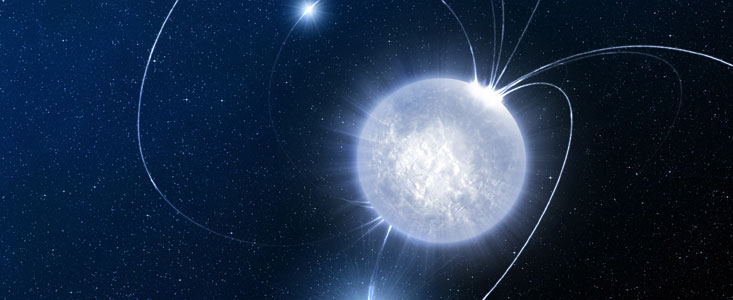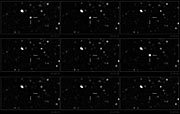Tisková zpráva
Hibernovaný hvězdný magnet
Objeven první opticky aktivní magnetar
23. září 2008
Astronomové objevili nejbizarnější kosmický objekt, který 40 krát zablikal a poté opět zmizel. Jedná se pravděpodobně o chybějící článek patřící do rodiny neutronových hvězd, první objekt se silným magnetickým polem, který vykazuje krátkou a silnou aktivitu i ve viditelném světle.
Tento podivný objekt nejprve zavedl své objevitele na špatnou stopu, když jej identifikovali jako klasický záblesk záření gama, který obvykle doprovází smrt hvězdy ve vzdáleném vesmíru. Krátce nato se ale zdroj projevil unikátními vlastnostmi, které ukázaly, že se nachází mnohem blíže. Po úvodním gama záblesku následovala třídenní aktivní perioda, během které bylo pozorováno 40 záblesků ve viditelném světle. Další epizoda záblesků, tentokrát infračervených, následovala za jedenáct dní, a byla zaznamenána přístroji ESO/VLT. Poté se zdroj stal opět neviditelným.
„Máme co do činění s objektem, který byl před touto krátkou aktivní periodou dlouhé období v hibernaci“, vysvětluje Alberto J. Castro-Tirado, hlavní autor článku, který vyšel v časopise Nature.
Nejpravděpodobnějším objektem, který by mohl projevit takto unikátní vlastnosti, je magnetar nacházející se v naší galaxii, asi 15 000 světelných let daleko směrem do souhvězdí Lištičky (Vul). Magnetary jsou mladé neutronové hvězdy s extrémním magnetickým polem, které je miliard miliard-krát silnější než v případě Země. „Pokud by se takový magnetar nacházel na půl cesty k Měsíci, vymazal by informace ze všech kreditních karet na Zemi“, říká spoluautor Antonio de Ugarte Postigo. „Magnetary zůstávají po dlouhá období klidnými. Přestože jich bylo dosud identifikováno jen několik, je pravděpodobné, že jich v Mléčné dráze existuje nemalá populace“.
Někteří vědci upozorňují, že s klesající silou magnetického pole by magnetary měly pomalu „odcházet na klidný odpočinek“. Doposud však nebyl nalezen žádný vhodný zdroj, který by takový vývoj u magnetaru potvrdil. Nově objevený objekt, známý jako SWIFT J195509+261406, který se projevil nejprve jako gama záblesk GRB 070610, je prvním možným kandidátem. Vysvětlení pozorovaného jevu prostřednictvím magnetaru je podpořeno ještě další studií, založenou na jiném vzorku dat, která vyšla v tomtéž čísle Nature.
Další informace
Článek od Castro-Tirado A. J. a kol. 2008, Flares from a candidate Galactic magnetar suggest a missing link to dim isolated neutron stars, Nature, 25. září 2008. Jiný článek od Alexe Stefanescu a kol. ve stejném čísle Nature hypotézu magnetaru potvrzuje.
Složení týmu: A. J. Castro-Tirado, A. de Ugarte Postigo, J. Gorosabel, M. Jelinek, M. A. Guerrero, F. J. Aceituno, R. Cunniffe, P. Kubanek, S. Vitek (IAA-CSIC, Granada, Spain), T. A. Fatkhullin, V. V. Sokolov, E. Sonbas, S. A. Trushkin, N. N. Bursov, and N. A. Nizhelskij (SAO, Russian Academy of Science), P. Ferrero, D. A. Kann, S. Klose, and S. Schulze (Thuringer Landessternwarte Tautenburg, Germany), D. Sluse (Laboratoire d'Astrophysique, Ecole Polytechnique Fédérale de Lausanne (EPFL) Switzerland), M. Bremer and J.M.Winters (IRAM, Saint Martin d d'Heres, France), D. Nuernberger (ESO, Santiago, Chile), D. Perez-Ramirez (Universidad de Jaen, Spain and University of Leicester, UK), J. French, G. Melady, L. Hanlon, and B. McBreen (University College Dublin, Ireland), K. Leventis and S. B. Markoff (University of Amsterdam, The Netherlands), S. Leon (IRAM, Granada, Spain), A. Kraus (Max-Planck-Institut für Radioastronomie, Bonn, Germany), A. C. Wilson (University of Texas, Austin, USA), R. Hudec (Astronomical Institute of the Czech Academy of Sciences), M. Durant, J.M. Gonzalez-Perez, and T. Shahbaz (IAC, La Laguna, Spain), S. Guziy (Nikolaev State University, Ukraine), S. B. Pandey (Aryabhatta Research Institute of Observational-Sciences, India), L. Pavlenko (Crimean Astrophysical Observatory, Ukraine), C. Sanchez-Fernandez (European Space Astronomy Centre, Madrid, Spain), and L. Sabau-Graziati (INTA, Madrid, Spain). Antonio de Ugarte Postigo is now affiliated with ESO, Chile.
Celkem 42 vědců z celého světa použilo data získaná prostřednictvím 8 teleskopů včetně: BOOTES-2 (robotický teleskop na EELM-CSIC), WATCHER teleskop na Boyden Observatory (Jižní Afrika), 0.8-m IAC80 na Teide Observatory (Španělsko), Flemish 1.2-m Mercator teleskop na Observatorio del Roque de los Muchachos (Španělsko), Tautenburg 1.34-m teleskop (Německo), 1.5-m na Observatorio de Sierra Nevada (IAA-CSIC), 6.0-m BTA v Rusku, 8.2-m VLT na ESO v Chile a IRAM 30-m Pico Veleta y Plateau de Bure teleskop, společně se satelity SWIFT (NASA) a XMM-Newton (ESA).
Neutronové hvězdy jsou odhalenými zhuštěnými jádry – pozůstatky velmi hmotných hvězd (s původní hmotností mezi 8 až 15 násobky hmotnosti Slunce), které při výbuchu supernovy odvrhly své vnější obálky. Neutronové hvězdy mají průměr kolem 20 km, stále jsou však hmotnější než naše Slunce.
Magnetary jsou neutronové hvězdy se silným magnetickým polem, které je asi 100 krát silnější než u obyčejných neutronových hvězd. Energie uvolněná magnetarem během jediného záblesku v aktivní periodě odpovídá energii, kterou Slunce vyzáří za 10 000 let.
Externí doplňující odkaz, není součástí originální tiskové zprávy ESO: na objevu se podíleli také čeští odborníci, podrobnosti naleznete v článku "Čeští vědci se podíleli na objevu vesmírného objektu nového druhu" na serveru astro.cz nebo přímo na stránkách Astronomického ústavu Akademie věd České republiky, v. v. i.
Kontakty
Alberto J. Castro-Tirado
IAA-CSIC
Granada, Spain
Tel.: +34 958 23 05 91
Email: ajct@iaa.es
Antonio de Ugarte Postigo
ESO
Garching, Germany
Tel.: +56 2 463 3062
Mobil: +34 61 60 31 753
Email: adeugart@eso.org
Anežka Srbljanović (press contact Česko)
ESO Science Outreach Network
a Astronomical Institute of Czech Academy of Sciences
Tel.: +420 323 620 116
Email: eson-czech@eso.org
O zprávě
| Tiskové zpráva č.: | eso0831cs |
| Legacy ID: | PR 31/08 |
| Jméno: | GRB 070610 |
| Typ: | Milky Way : Star : Evolutionary Stage : Neutron Star : Magnetar |
| Facility: | Very Large Telescope |
| Instruments: | FORS2, NACO |
| Science data: | 2008Natur.455..506C |
Our use of Cookies
We use cookies that are essential for accessing our websites and using our services. We also use cookies to analyse, measure and improve our websites’ performance, to enable content sharing via social media and to display media content hosted on third-party platforms.
ESO Cookies Policy
The European Organisation for Astronomical Research in the Southern Hemisphere (ESO) is the pre-eminent intergovernmental science and technology organisation in astronomy. It carries out an ambitious programme focused on the design, construction and operation of powerful ground-based observing facilities for astronomy.
This Cookies Policy is intended to provide clarity by outlining the cookies used on the ESO public websites, their functions, the options you have for controlling them, and the ways you can contact us for additional details.
What are cookies?
Cookies are small pieces of data stored on your device by websites you visit. They serve various purposes, such as remembering login credentials and preferences and enhance your browsing experience.
Categories of cookies we use
Essential cookies (always active): These cookies are strictly necessary for the proper functioning of our website. Without these cookies, the website cannot operate correctly, and certain services, such as logging in or accessing secure areas, may not be available; because they are essential for the website’s operation, they cannot be disabled.
Functional Cookies: These cookies enhance your browsing experience by enabling additional features and personalization, such as remembering your preferences and settings. While not strictly necessary for the website to function, they improve usability and convenience; these cookies are only placed if you provide your consent.
Analytics cookies: These cookies collect information about how visitors interact with our website, such as which pages are visited most often and how users navigate the site. This data helps us improve website performance, optimize content, and enhance the user experience; these cookies are only placed if you provide your consent. We use the following analytics cookies.
Matomo Cookies:
This website uses Matomo (formerly Piwik), an open source software which enables the statistical analysis of website visits. Matomo uses cookies (text files) which are saved on your computer and which allow us to analyze how you use our website. The website user information generated by the cookies will only be saved on the servers of our IT Department. We use this information to analyze www.eso.org visits and to prepare reports on website activities. These data will not be disclosed to third parties.
On behalf of ESO, Matomo will use this information for the purpose of evaluating your use of the website, compiling reports on website activity and providing other services relating to website activity and internet usage.
Matomo cookies settings:
Additional Third-party cookies on ESO websites: some of our pages display content from external providers, e.g. YouTube.
Such third-party services are outside of ESO control and may, at any time, change their terms of service, use of cookies, etc.
YouTube: Some videos on the ESO website are embedded from ESO’s official YouTube channel. We have enabled YouTube’s privacy-enhanced mode, meaning that no cookies are set unless the user actively clicks on the video to play it. Additionally, in this mode, YouTube does not store any personally identifiable cookie data for embedded video playbacks. For more details, please refer to YouTube’s embedding videos information page.
Cookies can also be classified based on the following elements.
Regarding the domain, there are:
- First-party cookies, set by the website you are currently visiting. They are stored by the same domain that you are browsing and are used to enhance your experience on that site;
- Third-party cookies, set by a domain other than the one you are currently visiting.
As for their duration, cookies can be:
- Browser-session cookies, which are deleted when the user closes the browser;
- Stored cookies, which stay on the user's device for a predetermined period of time.
How to manage cookies
Cookie settings: You can modify your cookie choices for the ESO webpages at any time by clicking on the link Cookie settings at the bottom of any page.
In your browser: If you wish to delete cookies or instruct your browser to delete or block cookies by default, please visit the help pages of your browser:
Please be aware that if you delete or decline cookies, certain functionalities of our website may be not be available and your browsing experience may be affected.
You can set most browsers to prevent any cookies being placed on your device, but you may then have to manually adjust some preferences every time you visit a site/page. And some services and functionalities may not work properly at all (e.g. profile logging-in, shop check out).
Updates to the ESO Cookies Policy
The ESO Cookies Policy may be subject to future updates, which will be made available on this page.
Additional information
For any queries related to cookies, please contact: pdprATesoDOTorg.
As ESO public webpages are managed by our Department of Communication, your questions will be dealt with the support of the said Department.



